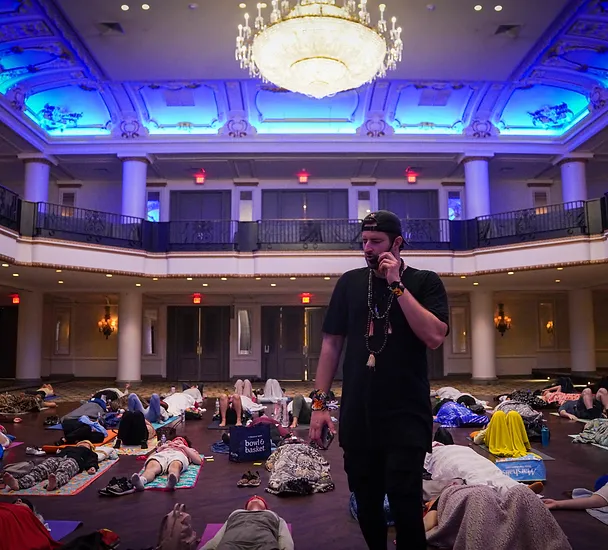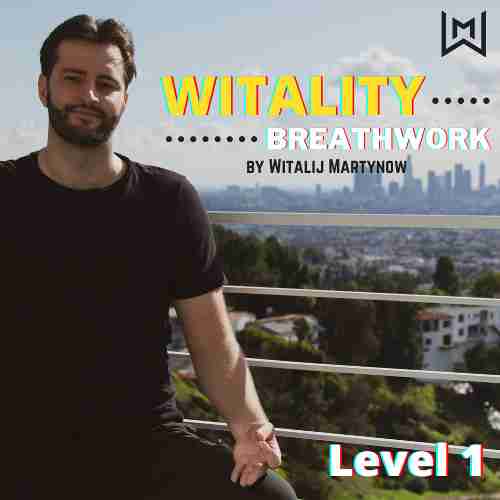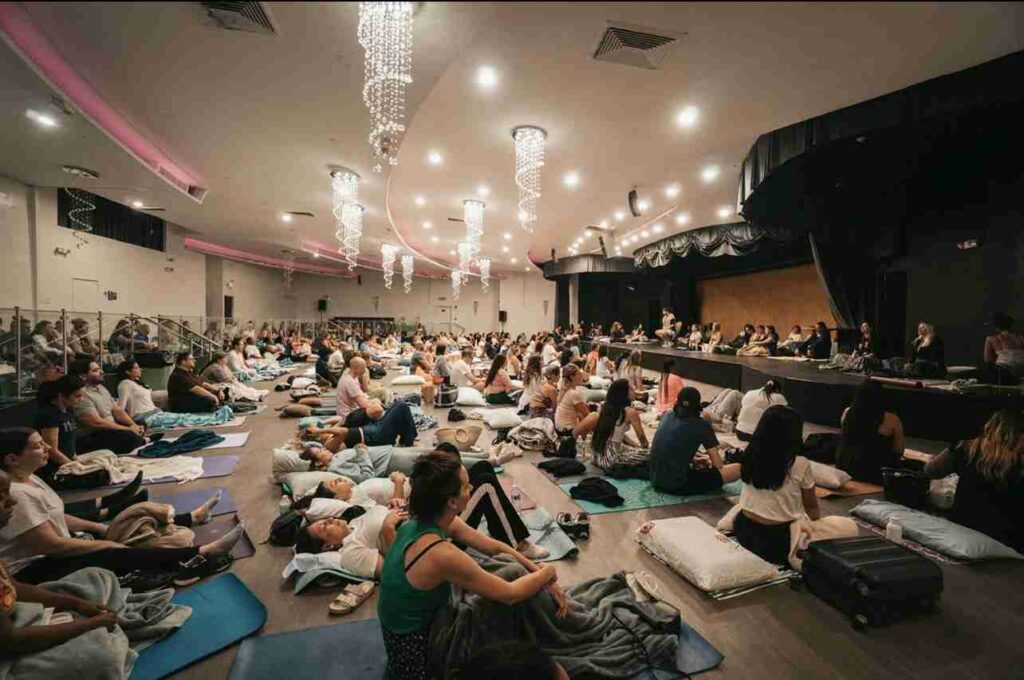Our bodies are composed of mostly water which means that we carry the energies and frequencies around us. Over time, negative energies/frequencies will build up which will cause blockage which in turn causes disease, sickness, and brain fog. I was lucky enough to attend a session hosted by Witalij Martynow (Witality) at the Hilton in Huntington Beach. The movement he has created has brought together thousands of people to get rid of these blockages, heal their bodies, and live their best lives.
Witality Breathwork
Breathing Exercises, Meditation and Philosophies: Witality Breathwork
This was the last city in Witalij’s 60-city tour over 65 days, quite impressive. Witality™ is a constantly evolving blend of breathing exercises, meditation, movement methods, and philosophies that Witalij Martynow discovered during his quest for health. He was paralyzed and used these techniques to gain his mobility back.
 These techniques not only proved effective for him but also rekindled vitality and energy in his life. Witalij’s method is a unique fusion of Eastern philosophy, the latest scientific discoveries, indigenous teachings, and his ancestral healing practices. The name Witality™ was conceived from a simple amalgamation of two words – ‘Witalij’, which means vigor and vitality in Russian, and ‘vitality’, signifying freshness and fullness in English.
These techniques not only proved effective for him but also rekindled vitality and energy in his life. Witalij’s method is a unique fusion of Eastern philosophy, the latest scientific discoveries, indigenous teachings, and his ancestral healing practices. The name Witality™ was conceived from a simple amalgamation of two words – ‘Witalij’, which means vigor and vitality in Russian, and ‘vitality’, signifying freshness and fullness in English.
Healing as a Group: Witality
The evening was hosted in the grand ballroom of the Hilton Hotel. Approximately 260 people gathered together on yoga mats covered with blankets. Witalij started the evening by telling us what was about to happen, how our physical and emotional blockages were about to be removed, and how we were in a safe space. He told us about his story and how this was the end of his 65-day tour. He was so ready for a vacation after this last session and who can blame him? He has only been doing these healing sessions for about a year and he has already experienced this amount of success!
An Visceral Experience with Sound and Guidance
We started by breathing in and out to the beat of the music. He had an incredible assortment of music with the ultimate surround sound. He mixed top 40 hits with emotionally driven songs and tribal beats. He took us on the ultimate journey as he narrated enticing stories and had us perform various breathing techniques. Our eyes were covered by blindfolds as we lay on our yoga mats, heads on our pillows. People started screaming. People started crying. Our emotional chains were starting to unlock person by person. You could feel the energy of the room as it was released.
Releasing Emotional Baggage
We hold on to so much emotional baggage as we live our everyday lives. Through breathing and meditation, Witalij is about to unleash these restrictive bounds. Yes, we were finally in a safe space to let all of this go. We forgave the ones who had wronged us. We knew our possibilities were endless. All of us had our own stories to tell and we were all so different, yet we had one thing in common…we came together to heal. We came to let go of our sorrows and our trauma. We were ready to live our best lives.

The next time Witality comes to your city, I would highly suggest you attend the event. Bring your friends, bring your loved ones…this is quite the experience. Witalij joked that we had joined a cult…well, I don’t know what this was…but I truly loved it. Thank you Witalij for the experience.
For more information visit Witality.
Dive into the transformative world of Witality™ Breathwork with Witalij Martynow. As a unique blend of ancestral teachings and scientific research, this breathwork technique can release emotional trauma, heal the body and mind, and create an immersive meditation experience. In this article, we explore the depth and breadth of Witality Breathwork, its benefits, and how you can be part of this healing journey.
Outline:
- What is Witality™ Breathwork?
- Who is Witalij Martynow and Why Should We Listen?
- How Does Witality™ Breathwork Work?
- The Connection Between Breath and Emotion
- What to Expect in a Witality Breathwork Session?
- How Can You Attend a Witality™ Event or National Tour?
- Is Witality™ Breathwork Good for Beginners?
- Releasing Emotional Trauma: Is it Real?
- The Scientific and Indigenous Teachings Behind the Technique
- Benefits of Incorporating Witality™ Breathwork into Your Life
1. What is Witality™ Breathwork?
Witality™ Breathwork is a unique breathing technique that Witalij Martynow has developed over many years. It combines the power of cognitive catharsis with powerful somatic release. Through this technique, individuals are able to heal emotional wounds and connect with their innermost emotions. The term ‘Witality’ comes from the fusion of vitality and Witalij’s name, emphasizing the life and energy the practice brings.
2. Who is Witalij Martynow and Why Should We Listen?
Witalij Martynow is not just someone who advocates for breathwork; he lives and breathes it. With numerous years of study in both ancient and modern breathwork techniques, Witalij believes in the transformative power of breathing. His events, videos, and teachings have touched the lives of many people, making him a trusted figure in the realm of breathwork.

3. How Does Witality Breathwork Work?
It’s all about harnessing the power of your breath. The breath, in Witalij’s teachings, is more than just an automatic process; it’s a tool for healing. Through specific patterns and techniques, individuals can release trapped emotions, meditate deeply, and even experience emotional breakthroughs.
4. The Connection Between Breath and Emotion
The breath is intrinsically linked to our emotions. When we’re scared, we might hold our breath, and when we’re relaxed, our breathing becomes more rhythmic. Witality™ taps into this connection, using the breath as a bridge to access, understand, and heal emotions.
5. What to Expect in a Witality Breathwork Session?
If you’ve ever attended a Witality Breathwork session, you know it’s more than just breathing exercises. It’s a deep emotional and spiritual dive into oneself. Sessions often include movement techniques, meditation, and group discussions to enhance the experience.
6. How Can You Attend a Witality™ Event or National Tour?
Witalij Martynow frequently hosts events and a national tour where participants can come and experience Witality™ Breathwork firsthand. Keep an eye on his official website or social media channels for upcoming dates and locations.
7. Is Witality™ Breathwork Good for Beginners?
Yes! While it’s a profound experience, beginners are welcome and are often provided with beginner level audio practices to ease into the process.
8. Releasing Emotional Trauma: Is it Real?
Many skeptics question the idea of releasing emotional trauma through breathing. However, countless testimonials and scientific research on the mind-body connection affirm the effectiveness of Witality™ in addressing and healing emotional pain.
9. The Scientific and Indigenous Teachings Behind the Technique
Witalij Martynow’s Witality™ Breathwork isn’t just a quick fix; it’s grounded in both scientific research and indigenous teachings. By combining the wisdom of ancestral ways of healing with modern science, Witalij has created a technique that is both deeply spiritual and scientifically validated.
10. Benefits of Incorporating Witality™ Breathwork into Your Life
Beyond just emotional healing, regular Witality™ Breathwork can lead to improved meditation, deeper sleep, reduced stress, and an enhanced connection to oneself. It’s not just a practice; it’s a lifestyle change.
Key Takeaways:
- Witality™ Breathwork is a unique breathing technique developed by Witalij Martynow.
- The practice combines scientific research with indigenous teachings, making it both an emotional and spiritual experience.
- Breath is deeply connected to our emotions, and by harnessing it, we can heal and transform.
- Witalij hosts numerous events and national tours for people to experience Witality™ firsthand.
- Regardless of your level of experience, Witality™ offers something for everyone.
Embrace the power of breath and embark on a transformative journey with Witalij Martynow’s Witality™ Breathwork. Whether you’re seeking emotional healing or a deeper connection to yourself, this practice is worth exploring.
Q: What is holotropic breathing?
A: Holotropic breathing is a psychotherapeutic breathwork technique developed by psychiatrists Stanislav and Christina Grof in the 1970s. It involves a specific pattern of rapid and deep breathing, often accompanied by evocative music and sometimes bodywork, with the aim of inducing altered states of consciousness. Practitioners of holotropic breathing believe that this altered state can facilitate self-exploration, personal growth, and healing by accessing non-ordinary states of consciousness and releasing suppressed emotions and memories. However, it is essential to approach holotropic breathing with caution and under the guidance of a trained facilitator due to the intensity of the experiences it can induce.
Q: How to do breathwork?
A: Breathwork encompasses a variety of techniques designed to promote relaxation, increase awareness, and improve mental and physical well-being. A simple technique to start with is diaphragmatic breathing:
- Sit or lie down comfortably in a quiet space.
- Place one hand on your chest and the other on your abdomen.
- Inhale deeply through your nose, allowing your abdomen to expand. The hand on your abdomen should rise more than the one on your chest.
- Exhale slowly and completely through your mouth, feeling the abdomen fall.
- Focus on your breath and repeat this process for several minutes.
Remember to consult a healthcare professional or a certified instructor before starting any new breathwork practices, especially if you have underlying health conditions.
Q: Can I do holotropic breathing alone?
A: Holotropic breathing is not recommended to be practiced alone due to the intense and sometimes unpredictable experiences it can induce. The presence of a trained facilitator or therapist can provide a safe and supportive environment, guide the individual through the process, and help integrate the experiences afterward. Practicing holotropic breathing alone can pose risks, especially for individuals with underlying mental health conditions.
Q: Is breathwork just hyperventilating?
A: Breathwork is a broad term that includes various techniques aimed at achieving different outcomes, such as relaxation, increased awareness, emotional release, and altered states of consciousness. While some techniques involve rapid breathing, breathwork is not synonymous with hyperventilating. Hyperventilation is a condition where an individual breathes rapidly and excessively, leading to decreased carbon dioxide levels in the blood, which can result in lightheadedness, tingling sensations, and fainting. In contrast, breathwork is a controlled and intentional practice with specific goals.
Q: Who shouldn’t do breathwork? (Witality)
A: Individuals with certain medical conditions, including cardiovascular disease, respiratory issues, high blood pressure, or a history of psychiatric conditions, should exercise caution and consult a healthcare professional before engaging in breathwork. Pregnant individuals and those with a history of seizures or panic attacks should also seek medical advice before starting breathwork practices. It’s crucial to choose a technique that is appropriate for one’s individual health and well-being and to practice in a safe and supportive environment.
Q: Who shouldn’t do holotropic breathwork?
A: Holotropic breathwork can be particularly intense and is not suitable for everyone. Individuals with cardiovascular issues, respiratory problems, psychiatric disorders, epilepsy, or those who are pregnant should avoid holotropic breathwork unless under medical supervision. Additionally, individuals with a history of trauma or severe mental health conditions should approach holotropic breathwork with caution and ideally under the guidance of a trained and experienced therapist.
Q: What is magic breathing? (Witality)
A: “Magic breathing” is not a standard or universally recognized term in breathwork or wellness practices. It might be used colloquially to describe a specific breathing technique that someone finds particularly beneficial, transformative, or “magical” in its effects. Given the ambiguity of the term, it’s important to seek clarification on what is meant by “magic breathing” and to ensure that any breathing practice undertaken is safe, appropriate, and guided by credible sources or practitioners.
Q: Why do I cry during breathwork? (Witality)
A: Crying during breathwork can be a natural and cathartic release of stored emotions. Breathwork techniques can help individuals access and process emotions that may have been suppressed or unacknowledged, leading to a sense of release and relief. The act of breathing deeply and intentionally can activate the parasympathetic nervous system, promoting relaxation and emotional release. It’s essential to be in a supportive and safe environment when practicing breathwork, especially if strong emotions arise, and to seek guidance from a trained professional if needed.
Q: What are the 4 types of breathing?
A: The four types of breathing are:
- Diaphragmatic Breathing: This involves breathing deeply into the diaphragm, allowing the abdomen to expand and contract with each breath. It promotes relaxation and is beneficial for stress reduction.
- Costal (Thoracic) Breathing: This type of breathing expands the rib cage, primarily involving the intercostal muscles. It is shallower than diaphragmatic breathing.
- Clavicular Breathing: This is the shallowest form of breathing, involving the raising of the collarbones and shoulders. It is often associated with stress and tension.
- Yogic Complete Breathing: This is a combination of diaphragmatic, costal, and clavicular breathing, aiming to utilize the full capacity of the lungs for optimal oxygenation.
Q: Can breathwork release trauma?
A: Breathwork has the potential to help individuals release and process trauma by accessing and addressing stored emotions and memories. Some people report experiencing cathartic emotional releases and insights during breathwork sessions. However, it is essential for individuals with a history of trauma to approach breathwork with caution. Trauma-sensitive breathwork, ideally guided by a trained therapist or healthcare professional, can provide a safe and supportive environment for exploring and processing traumatic experiences. It’s also important to integrate any insights or releases with ongoing therapeutic support.

